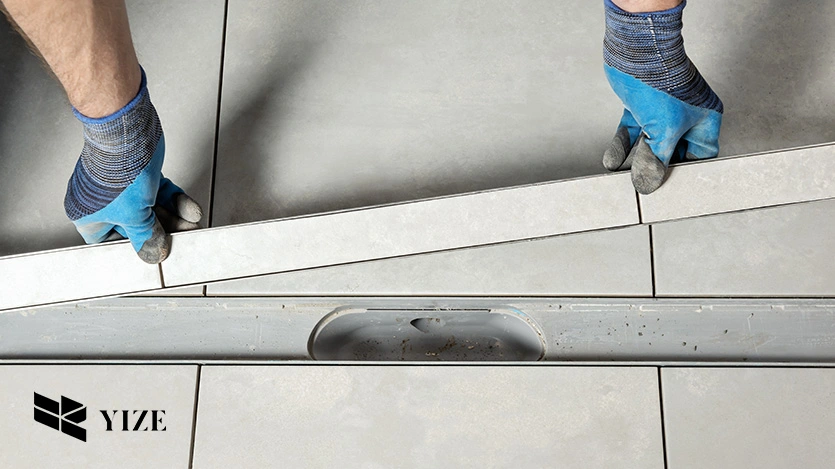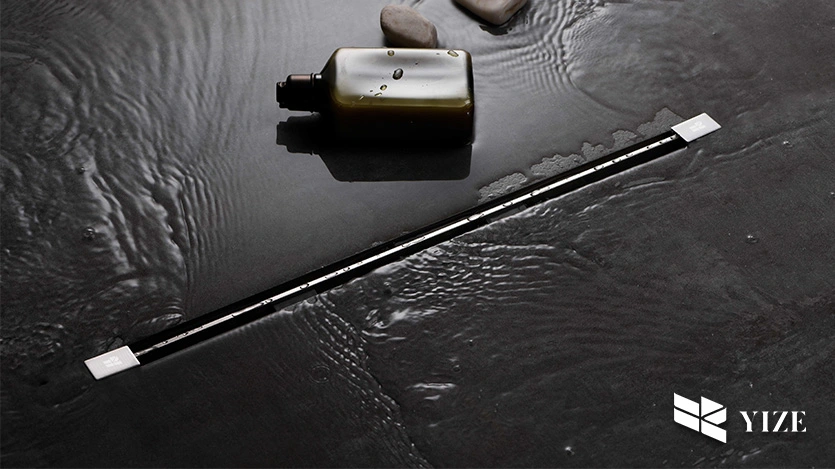
I. Introduction
Linear shower drains have been adopted extensively in modern bathroom designs because of their aesthetic nature and efficiency in water drainage. They give your house a modern appearance, and they are functional as well, which is why users and building contractors prefer them.
Linear shower drain installation is sensitive and plays a very important role in its use. This decreases chances of water pooling, facilitates water drainage and makes the area appear aesthetically pleasing. The information provided in this guide will assist you to pinpoint and properly install linear shower drains in the year 2024.
II. linear Shower Drains – Components and Working Principles
Linear shower drains are long slim drains that lie across the floor of the shower. Linear drains are not like the conventional round or square drain where water flows into the drain at the center; water flows from the sides of the shower and is collected along the length of a linear drain. These drains are fixed either on the side or in the middle of the shower according to the floor plan of the shower.
- Aesthetic Appeal: They give a chic and sleek appearance that is well fitting for a new generation bathroom design.
- Efficient Drainage: It has a longer dimension which enhances the rate of water ejection so that there is minimal formation of water pools.
- Accessibility: Finally, linear drains can be easily integrated into the barrier-free showers which are quite beneficial for a physically challenged individual.
III. eciphering the Optimal Placement for a Linear Shower Drain in a New Shower
- Shower Layout: Depending on the size and design of the shower enclosure, the most appropriate position for drain installation will be determined.
- Water Flow: The device should be fitted in a position that will ensure that water is always flowing and not stagnated.
- Slope: For better drainage, the floor of the shower stall should have a slight downward inclination toward the drain.
- Aesthetic Considerations: The design of the drain should also blend with the rest of the shower area space.
The linear shower drain must be fitted at the lowest point around the shower area to encourage proper water disposal. This, of course, can be along one of the walls or at the center if the design of the shower allows this. The other important consideration is to ensure that the floor is inclined slightly towards the drain to enhance water evacuation.
IV. reparations for Installing a Linear Shower Drain
Before starting the installation, gather the following materials and tools:
- Linear shower drain kit
- Measuring tape
- Level
- Screwdriver
- Drill
- Saw (if cutting tiles or flooring)
- Waterproof membrane
- Mortar or thin-set
- Trowel
- Grout
V. Safety Measures to Take Before Starting the Procedure
- Wear Safety Gear: In the course of the installation wear hand gloves and safety goggles to protect the skin and eyes respectively.
- Turn Off Water Supply: Make sure that the water supply to the shower area is off before you undertake the repairs.
- Read Instructions: Read the manual that comes with the product and ensure that you follow all the installation steps as directed.
In its section, YZDRAIN, being one of the top manufacturers of linear shower drains stated that the most suitable position of a linear drain would be at the wall to which the shower head is not fixed. It also guarantees that water is drained well on the sink and does not accumulate on the basin surface. They also advise on the need to guarantee that the shower floor slopes towards the drain at a constant angle.
VI. Step-by-step Guide on How to Install a Linear Shower Drain

- Plan the Placement: Decide on the best place that the drain will fit best taking into consideration the above factors.
- Prepare the Floor: Be certain that the floor of the shower and the surrounding area are free from any dust or debris. In case it is impossible to put the drain in the middle of the tiles or flooring, the latter has to be trimmed.
- Install the Waterproof Membrane: Install the waterproof membrane to the shower floor and walls as described in the product manual.
- Set the Drain: Install the linear drain in the identified location. Level it by using a level to make sure that it is straight.
- Connect the Plumbing: Secure the drain to the other existing pipes in the house and ensure that the joints are well fitted.
- Apply Mortar or Thin-set: Apply the mortar or thin-set around the drain to establish a firm base for it to sit on.
- Tile the Floor: Place tiles around the drain area, and work to ensure that the tiles are aligned and slanting towards the drain.
- Grout the Tiles: After placing the tiles, apply grout to the tile joints and the perimeter of the drain.
- Seal the Edges: Seal the area around the drain with a waterproof agent to help reduce the chances of leakage.
Clarification of Common Concerns During the Installation Process
- Ensuring Proper Slope: Level the floor of shower in a manner that it slopes towards the shower drain. This must be done according to the circumstances in order to cater for a proper water drainage.
- Secure Connections: It is also important that all the plumbing links should be well fastened to minimize the risks of leakage.
- Proper Alignment: It is also important to check the position of the drain and tiles in relation to each other during the construction process to avoid uneven surface.
VII. is takes to Avoid While Installing a Linear Shower Drain
- Incorrect Slope: Unless there is a slope created towards the drain, water tends to pool up.
- Poor Waterproofing: Failure in proper application of the waterproof membrane exposes the structure to potential leakage and water damage.
- Improper Drain Placement: If the drain is installed in a wrong position so that it cannot allow water to flow through it in an efficient manner, then it might not be that useful.
How to Effectively Avoid These Errors to Ensure a Smooth Installation?
- Check the Slope: Ensure you monitor the slope of the shower floor when installing and make needed adjustments as you go on with the process.
- Follow Waterproofing Instructions: It is crucial to adhere to all the guidelines stated by the manufacturer of the waterproof membrane.
- Plan Placement Carefully: Spending the time to place the drain appropriately can help to create the proper movement of water and flow.
VIII. The Importance of Professional Installation

- Complex Shower Designs: If the shower is combined with other fixtures or has an unusual configuration, you may want to call a specialist to make sure that the drain is properly placed.
- Limited DIY Experience: If you are a novice to DIY projects, you should employ the services of a professional to avoid wasting time as well as making expensive mistakes.
- Building Codes and Regulations: Most of these professionals have knowledge of the local laws governing construction projects and will see to it that the installation meets these laws.
Hiring a professional to install your linear shower drain can go a long way in extending the system’s lifespan and performance. Professionals have the experience to warrant that the drain is installed properly, and this will reduce cases of leakage or other problems. This can lead to longer lasting and functional drainage system in that will serve them for years of quality service.
IX. Conclusion
The position and installation of a linear shower drain are critical to the effective drainage of water and also for overall bathroom design. Spending some time on planning the placement, searching for necessary accessories, and following a step-by-step installation guide ensures the creation of a convenient and aesthetically pleasant shower zone.
Everything you need to know to order and install a linear shower drain is in this guide, which is specifically for 2024. If you follow these guidelines and what not to do, your shower drain will work as it should be and complement the aesthetics of the bathroom.
Frequently Asked Questions (FAQs)
What is a linear shower drain?
A linear shower drain is a type of drain that is long and narrow and it runs along the floor of a shower and helps in the drainage of water over a larger surface area.
On what basis is the positioning of a linear shower drain critical?
Correct positioning provides drainage of water, avoids water accumulation, and adds beauty to the shower zone.
What type of materials and equipment are required for the installation of a linear shower drain?
Linear shower drain kit, measuring tape, level, screwdriver, drill, saw, waterproof membrane, mortar or thin-set, trowel, and grout are needed in the process.
